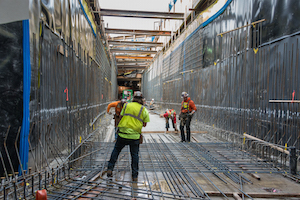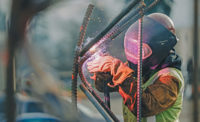
As crews in July removed a wall that separated existing rail track from the construction zone for a segment of the light-rail system that will connect downtown Seattle to the University of Washington’s Husky Stadium, the nearly $2-billion project, which includes two underground stations and 3.15 miles of bored track, remains about six months ahead of schedule six years into construction. The owner, Sound Transit, is about $150 million under the approved budget.
“We mention that every chance we get,” says Joe Gildner, Sound Transit’s ULink project director.
He attributes project success thus far to proper planning, including “designs that have held up well” and a proper risk-management balance under multiple contracts.
The project has faced challenges, but, to date, the contractors have handled them, Gildner says. Working under more than a dozen contracts, five main contractors are responsible for the bulk of the work. Tunneling crews came from the joint venture of Traylor Bros./Frontier-Kemper and the joint venture of Jay Dee Contractors, Livonia, Mich.; Frank Coluccio Construction Co., Seattle; and Michaels Corp., Brownsville, Wis. The Seattle office of Portland-based Hoffman Construction Co. built the University of Washington station; the Seattle office of New York City-based Turner Construction is wrapping up the Capitol Hill station, and the Seattle office of Stacy and Witbeck, Alameda, Calif., is handling all systems work in the stations and tunnels. The large number of prime contractors allowed each of them to focus on a specific expertise, says Scott Holbrook, Turner project executive.
The project always keeps its top-five risks at the forefront of planning. Early on, 21 cross-passage tunnels, all 21 ft in dia, could have dealt Sound Transit a major blow. Despite a number of tough segments—mining 15 ft below an underwater crossing of Montlake Cut, crossing within 13.5 ft below Interstate 5 and diving as much as 320 ft under Capitol Hill, while tunneling 53 ft per day between Capitol Hill Station and Pine Street Stub Tunnel and 71 ft per day between University of Washington Station and Capitol Hill Station—crews had to deal with a significant volume on groundwater only once. Even Seattle’s typically damp and dreary weather resulted in only three days of delay in more than six years.
With the tunneling finished, Gildner says 3D modeling for the two subway stations allowed crews to go room by room, level by level and area by area to search for interface, mechanical, electrical and systems issues. “It helped to eliminate a lot of frustrations and challenges that happen in the field,” he says. “It is something we are going to continue to use and one way to help us mitigate risk.”
Holbrook says that, with so many primes working together, modeling was a “big piece of our project success.” He notes, “The guys doing the tunnels can’t get down there unless they go through [our] station. We have to work out a plan. Material delivery is a big piece for us to make sure we can get stuff down and coordinate while still under construction.” Sound Transit created an entire set of “solid communication protocols to try [to] deal effectively with risks by addressing them as a collection,” Holbrooks says.
Sound Transit invested in up-front programming. A new data-mining software system—Autodesk Navisworks—gave the team more reliability and capability to gather information on everything from train control to building management information, helping with not only its coordinated installation program but also with building management. The agency used design-bid-build contracts on the stations and general-contractor/construction-manager contracts for tunnels, where Sound Transit has less experience.
“I think, when it comes to tunneling, you have to look at capabilities,” Gildner says. “When it comes to station finish work, we have found [that] the ability to bring in a contractor in preconstruction and work through issues, room by room and area by area, before [we] go into construction is very helpful for the team in terms of ability to arrive at a total cost contract. We were able to negotiate, and it helped us complete the design, but the record stayed with us.”
As the project continues past the completion of the tunnels and the University of Washington Station, which is nine stories underground, Sound Transit expects to get substantial completion on the 630-ft-deep Capitol Hill Station from Turner this month, with Stacy and Witbeck’s portion wrapping this fall. Then, Sound Transit will turn over the station to operations for testing, planning for carrying passengers in the first quarter of 2016, ahead of the September 2016 deadline.
Both subway stations feature center-platform structures: At the Capitol Hill Station, the top of rail is about 65 ft below the ground surface and the platform width is just over 49 ft; at the University of Washington Station, the top of rail is 90 ft underground, with a platform width of 58 ft. Building infrastructure below the campus had the potential to create ground vibrations that could have impacted sensitive research and magnetic operations at the university.
Sound Transit opted for floating concrete slabs and concrete-rubber pads to help control the vibration and contain the underground work. The typical slab design is 46 in. long and 9 ft, 5 in., wide about 2 ft below ground. A second type of slab, 94 in. long, is used for splicing cables at 60-ft intervals. Each slab is supported by four elastomer pads and restrained horizontally with two side pads. Two separation pads are placed between adjacent slabs. The natural rubber-based support pads have an unloaded thickness of 7.5 in. and an outer dia of 12.5 in. Using “ultra-straight rail” for the first time also should mitigate vibration. Working in collaboration with the school and experts, Sound Transit will do extensive testing to ensure it has handled any issues.
“The successes so far on ULink have been a team effort, from the early designers to the contract packaging to having great contractors communicating with each other and Sound Transit as the owner. This project has been a model we hope to repeat as we continue building out the light-rail system,” says Ahmad Fazel, executive director for Sound Transit Design, Engineering and Construction Management.
Holbrook says, “Sound Transit did a good job in creating an overall framework of how you hand things off.”



Post a comment to this article
Report Abusive Comment